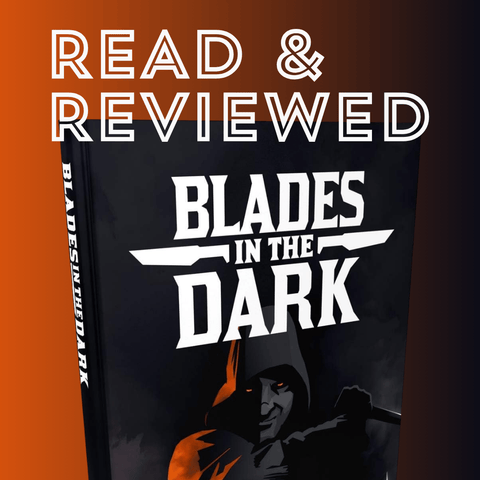by Sharang Biswas
On Saturday, June 14, 2025, I sat listening to a panel of authors discuss queerness in science fiction in an upstairs room at a gay café in Washington DC, while a neighbourhood or two away, the streets were being prepped for a pompous parade aggrandizing the glories of American military might.
It struck me—in the way a chronic illness might strike, arbitrarily and forcefully despite one’s constant awareness of it—that in many parts of the world, being gay is still a crime.
We are reminded of this every time someone chants “Be Gay, Do Crime”. Not all laws are just; “criminal” and “amoral” are not synonyms. We do not have to look that far back in history for proof.
© Evil Hat Productions
Distilled down to its fundament, John Harper’s Blades in the Dark (BitD) is a game about committing crimes. Players embody a gang of cutthroat scoundrels clawing their way up the criminal hierarchy by conducting daring heists in an incurably haunted, Victorian-esque city surrounded by lightning barriers powered by demon blood.
If that sounds like a lot, it very much is—in the best possible light. Even stripped of all game mechanics, BitD’s central setting—the city of Duskwall—suffices to yank players into the game. John Harper (credited in the book for Game Design, Writing, Layout, Art, and Cartography) etches for us a textured, highly compelling world that demands attention. Game Masters are told just enough about the gangs, canals, neighborhoods, institutions, politics, ghosts, demons, and cults of Duskwall to populate their player’s stories with exciting obstacles and allies. I dare you to show me a player who is not intrigued by the city’s official religion: “The Church of The Ecstasy of the Flesh”, or who isn’t immediately captivated by the bronze-masked Spirit Wardens who employ a cohort of Deathseeker ravens in their continuous quest to locate the recently deceased in order to capture and electrocute fledgling ghosts before posthumous insanity sets in!

© John Harper
Yet, Harper spares us the reams of tedious lore that many TTRPGs feel are necessary for players, in favour of suggestive vignettes and intriguing questions. What are the seven, strange reflections of the moon that one sometimes spots in the night sky? What do the Reconciled, an ancient alliance of possessor-spirits infiltrating the city’s government, really want? The answers to these sorts of questions are left to the GM—or perhaps the players. Harper’s play philosophy distributes far more authority to the players than in traditional roleplaying games. This is reflected in the game mechanics, too. For instance, which character-specific numerical statistic a player uses during a dice roll is determined by them, not the Game Master (imagine telling a GM of a swords-and-sorcery game that you’d like to use your Intelligence over your Strength for a particular challenge, and you get the picture); the game then provides mechanism for the GM to deal with any unconventional choices. Then, there’s the information listed on character sheets: equipment is presented with no explanation, with at most a scant 1-2 line description in the book; each character has a list of underworld contacts, but all the sheet provides is a name and profession. It is left to players to collaborate, discuss and carve out the world’s fine-grained textures.
While this style of play might sound daunting to those more familiar with more old-school games, trust me, it really isn’t. Part of it is simply because BitD gives players permission to contribute additively to the game’s setting. It’s written into the book. “No one is in charge of the story,” Harper exhorts in bold typeface, followed by suggestions as to which kinds of judgement calls belong to players and which to the GM.

© John Harper
But part of it is the straightforwardness of the game’s core mechanic. Obstacles/enemies have few real “stats”, save for maybe a single-digit number marking their “tier”. Game Master’s have no need to pre-plan “balanced encounters” or flesh out an NPCs numbers. There are no variable “difficulty classes” for success on a dice roll. Much like Powered by the Apocalypse games—credited as inspiration—BitD employs a universal criterion marking success on a die roll: however many dice one rolls (depending on player-character stats, and optionally, resources spent), a single 4/5/6 indicates a success (with complications if no 6 appears). Here, the GM’s job is mainly to determine the narrative stakes: what the consequences for success or failure might be. This simplicity and transparency of game mechanics—coupled with a robust collection of inspirational appendices and tables—makes BitD supremely easy to run. Personally, when tasked with running a game at short notice, the deluxe edition of Blades in the Dark sitting on my RPG shelf is one of my go-to options. I ran it for my annual Pride weekend game this year (for a table of self-styled “non-gamers”).
One of the hallmarks of an elegant RPG system is the use of simple mechanics to produce complex emotional affect. Because remember, BitD is fundamentally about crime. In the real world, crime is rarely black-and-white. Old-school comic-book ideas that position good, virtuous people firmly on the side of the law, and evil, malicious people on the criminal side have never been realistic. In the real world, social pressure and economic systems designed to exploit the marginalized give rise to much of the world’s lawbreaking. In the real world, powerful people identify actions that inconvenience them and call them crimes.

© John Harper
Duskwall is not a city of shiny heroes and moustache-twirling evildoers. It’s a city rife with drugs, deception, backstabbing and blackmail at all levels of power. It’s a city of corrupt “Bluecoat” law enforcers shaking down shopowners through protection rackets, a city where the poor try to make a buck selling the highly dangerous distilled essences of ghosts in order to buy a handful of the rare, fresh vegetables grown in dangerously poisonous “radiant gardens” (did I mention that in Duskwall’s world, the sun died out a thousand years ago?). Even if your scoundrel character starts off as a saint, they’ll likely become an asshole as stress and trauma from the city streets work their corrupting influence on their morality.
These merciless forces of stress and trauma aren’t just narrative, but codified into their own toothy set of game systems. While the basic conflict resolution mechanics might be simple to execute, the game provides a satisfying mouthful of complexity through numerous interlocking systems and resources to track (not just stress and trauma, but also funds, experience, wounds, how much “heat” your crew has gained with the authorities, relationships to various factions, territory controlled, progress on special projects, and more) plus a whole “downtime” phase your scoundrels engage in between heists (or “scores” in the game’s lingo). There’s even a separate system concerning your scoundrel being sent to prison, including new assets they can gain only through incarceration.

© John Harper
What many of these game systems achieve is instill a feeling of competence in players. You’re not simply two-bit hired thugs, but a functioning team of lawbreakers, each with their own expertise. The dice system itself reliably leads to qualified successes over outright failures. Furthermore, rules exhort, “Don’t make the PCs look incompetent. When a PC rolls a 1-3, things go badly, but it’s because the circumstances are dangerous or troublesome—not because the character is a buffoon.” Then, there are numerous smaller mechanics that enhance the “I-am-a-slic-Ocean’s-11-operative” feel of the game: inventory management and flashbacks are perhaps the most well-known pieces of BitD’s design.
A character’s inventory is not tracked traditionally; rather, a scoundrel only determines how much they’re carrying before a score, with the ability to decide on the fly what it is they actually possess (from their prescribed list of items) as the situation sees fit. Again, this makes it feels like they’re actually prepared for a mission, rather than stumbling around like most traditional RPG characters.

© John Harper
Flashbacks are a powerful tool in a player/scoundrel’s arsenal. Simply put, a player can call for a flashback at any time to insert fiction into the story’s past in order to change the narrative present. Say, for instance, that your scoundrel is spotted in flagrante delicto by a guard. You have the power to gain some stress and call for a flashback scene, where you establish that a week prior, your crew blackmailed this very guard by threatening to expose his sordid side-business to his employers. Cut back to the present and that guard now happily ignores you while you proceed to break into that vault you were tinkering with. Together, the mechanics make you feel good about doing crime, and the game makes it clear that your criminal endeavours tend to move towards ideas of resistance against oppressive and authoritarian forces. It’s not all moralistic do-goodery, but BitD’s version of a power fantasy—complicated and messy—is a lovely counterpoint to Tolkeinesque representations of binary good and evil commonly depicted in games.
Blades in the Dark is a game about crime. However, John Harper isn’t interested in outright simulationism. Rather, Blades In the Dark relies on popular conceptions of heist and crime fiction, weaving together gritty trauma and violence with power-fantasy ideas of shrewd, competent skullduggery to create a game where daring heists directly oppose the corrupt ruling class. It’s a game that asks players and GMs to yell in unison—with great lungfuls of ash-filled, demon-touched, ghost-poisoned air—to “Be Gay. Do Crimes.”
I know I did.

© John Harper
DISCLAIMER: Sharang was a Design Consultant for BLADES IN THE DARK: DEEP CUTS and has spoken on panels hosted by Evil Hat Games
Sharang Biswas has won two IGDN awards, four Ennie Awards, an IndieCade award, and a Golden Cobra award for roleplaying games, as well as the Brave New Weird Award for fiction. He has showcased interactive works at institutions such as The Institute of Contemporary Art in Philadelphia, Pioneer Works in Brooklyn, the Toronto Reference Library, and The Museum of the Moving Image in Queens. He has worked on games such as Avatar: Legends, Pathfinder, Vampire: The Masquerade, Spire: The City Must Fall, Moonlight on Roseville Beach, Jiangshi: Blood on the Banquet Hall, and Dungeons & Dragons Live, as well as boardgames including Holi: Festival of Color, Mad Science Foundation, and Sea of Legends. His fiction and poetry has appeared in Lightspeed, Nightmare, Augur, Strange Horizons, Baffling, and more. He is the co-editor of Honey & Hot Wax: An Anthology of Erotic Art Games (Pelgrane Press) and the author of science-fiction novella The Iron Below Remembers (Neon Hemlock Press). Sharang currently teaches games at the NYU Game Center and Fordham University.
© 2025 Tabletop Bookshelf






Comments (0)
There are no comments for this article. Be the first one to leave a message!